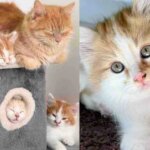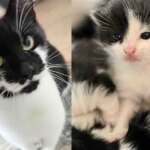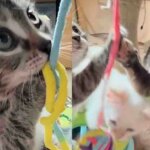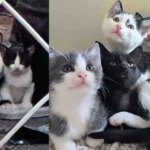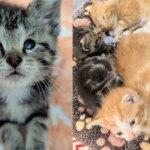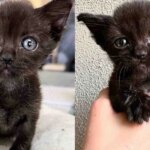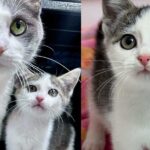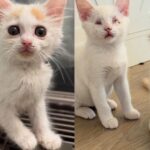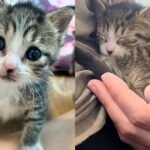Have you ever wished that you could understand what your cat is trying to tell you? Well, the good news is that with a little knowledge and observation, you can! Cats have a unique way of communicating through cat body language, using subtle movements and expressions to convey their thoughts and feelings.
By learning to decipher these non-verbal cues, you can develop a deeper understanding of your feline companion.
In this article, we will explore the fascinating world of cat body language. We will delve into the meaning behind tail movements, ear positions, eye expressions, body postures, vocalizations, facial expressions, and grooming behaviors. Each of these aspects provides valuable insights into your cat’s mood and intentions.
Understanding your cat’s body language not only helps strengthen the bond between you and your furry friend but also allows for better communication and mutual understanding. So get ready to unlock the secrets hidden in those twitching tails and perked-up ears; it’s time to uncover what your cat is saying without words!
- Tail Movements
- Ear Positions
- Eye Expressions
- Body Postures
- Vocalizations
- Facial Expressions
- Grooming Behaviors
- Frequently Asked Questions
- How can I tell if my cat is angry or annoyed based on their tail movements?
- What does it mean if my cat’s ears are constantly twitching?
- Are there any specific eye expressions that indicate my cat is feeling fearful or anxious?
- What body postures should I be aware of that may signal my cat is in pain or discomfort?
- Can cats communicate different messages through their vocalizations, or do they all mean the same thing?
- Conclusion
Tail Movements
When your cat’s tail starts to twitch, it’s a sign that they’re getting annoyed or agitated. This behavior is known as tail flicking and it’s their way of expressing their irritation. You may notice that the flicks become more pronounced and rapid when they are becoming increasingly annoyed.
On the other hand, if your cat’s tail is wagging gently from side to side in a relaxed manner, it usually indicates that they’re feeling content and happy. Understanding these different tail movements can help you better communicate with your feline friend. It allows you to recognize when they need space or when they’re seeking attention and affection.
Now that we’ve covered the importance of reading your cat’s tail language, let’s move on to another vital aspect of understanding them: ear positions.
Ear Positions
When it comes to understanding your cat’s body language, ear positions play a crucial role. Forward-facing ears indicate that your cat is alert and interested in their surroundings.
On the other hand, flattened ears suggest aggression or fear, indicating that your cat may be ready to defend itself.
Twitching ears can signal annoyance or excitement, so pay attention to these subtle movements as they can provide valuable insight into your feline friend’s mood.
Forward-facing ears
With their ears perked forward, your cat is like a radar dish, tuned in to every sound around them. Forward-facing ears are a clear indication that your feline friend is alert and interested in their surroundings. When their ears are pointed forward, it means they’re actively listening and ready to react if needed.
This position also allows them to better locate the source of the sound. Cats use their ears not only for hearing but also for communication. By positioning their ears forward, they’re signaling that they’re open to interaction and engagement with you or other animals.
Understanding the significance of a cat’s ear position can help you better interpret their moods and intentions.
Now, let’s move on to the next section about flattened ears…
Flattened ears
In a state of alertness, a cat’s ears can be seen flattened. This body language is an indication that your feline friend is feeling threatened or fearful. Understanding this behavior is crucial as it allows you to respond appropriately and provide comfort to your cat.
When the ears are flattened, it could also be a sign of pain or discomfort caused by ear infections or ear mites. It’s important to regularly check your cat’s ears for any signs of infection or mites. If you notice redness, swelling, discharge, or if your cat frequently scratches at their ears, consult with a veterinarian for proper diagnosis and treatment.
By being aware of these signals and taking quick action, you can ensure the well-being of your beloved pet.
Now let’s move on to the next section about ‘twitching ears’…
Twitching ears
Twitching ears can be a sign that your cat is feeling agitated or irritated. It’s estimated that cats twitch their ears around 12 times per minute on average. This behavior is a way for cats to communicate their emotions without using words. When a cat’s ears start to twitch, it usually means they are on high alert and ready to defend themselves if necessary. They might be hearing something that caught their attention or sensing danger nearby. Pay close attention to the direction of the ear twitches as well, as it can give you clues about what has grabbed your cat’s interest.
Now, let’s move on to another important aspect of understanding your cat’s body language – eye expressions.
Eye Expressions
When it comes to understanding your cat’s eye expressions, there are a few key points to keep in mind. Firstly, pay attention to their pupils – if they’re dilated, it could indicate excitement or fear.
Secondly, half-closed eyes can be a sign of relaxation and trust.
Lastly, the way your cat stares or blinks at you can communicate different messages – a prolonged stare may signify aggression while slow blinking is often seen as a sign of affection and contentment.
By observing these cues, you’ll have a better understanding of what your feline friend is trying to communicate without words.
Dilated pupils
Notice how your cat’s pupils expand and contract, revealing their emotions and intentions without a single meow or purr. Dilated pupils can indicate various states of mind in your feline friend.
When your cat is excited or aroused, their pupils may enlarge to take in more light and gather information about their surroundings. On the other hand, if they feel threatened or scared, their dilated pupils serve as a warning sign to potential aggressors. Additionally, when your cat is ready to pounce on prey or playfully engage with you, their pupils tend to dilate as well.
Pay attention to other cues such as paw positioning and vocalizations alongside dilated pupils to better understand what your furry companion is trying to convey. Speaking of paw positioning, let’s now explore another important aspect of feline body language: half-closed eyes.
Half-closed eyes
With their eyes half-closed, your cat reveals a serene and contented state of mind, as if basking in the warm glow of sunlight. This sleep behavior is not just a sign of relaxation but also an indication of trust and comfort in their environment.
When your cat feels safe, they’ll often exhibit this sensory perception by partially closing their eyes to filter out excessive light and focus on their surroundings with heightened sensitivity. The slow blinking that accompanies half-closed eyes is an invitation for you to reciprocate the gesture, signaling that you’re not a threat and fostering a deeper bond between you and your feline friend.
Understanding this body language can help strengthen your relationship and create a sense of peace and understanding between you both.
Staring or blinking
Staring into your cat’s eyes or returning their slow blink can deepen the bond between you, creating a sense of peace and understanding. When your cat stares at you, it’s usually a sign of affection and trust. They’re trying to communicate with you without using words. Similarly, when you stare back or give them a slow blink, it shows that you acknowledge their presence and reciprocate their feelings. This simple act can strengthen the connection between you and your feline friend.
On the other hand, long stares may indicate that something’s bothering your cat. It could be a sign of fear or aggression. In such cases, it’s important to observe their body language along with the staring to fully understand what they’re trying to convey.
Moving on to body postures…
Body Postures
As your cat curls up into a tight ball with their tail wrapped around them, it’s a clear sign that they’re feeling relaxed and content.
Another important aspect of your cat’s body language is their paw positions. When your cat is feeling calm and at ease, they’ll often tuck their paws neatly underneath their body. This shows that they’re not on guard and feel safe in their environment. On the other hand, if you notice your cat’s paws splayed out or extended, it may indicate that they’re feeling defensive or ready to attack.
Head tilting is also an important body posture to pay attention to. If your cat tilts their head slightly to the side when looking at you or something else, it shows curiosity and engagement. This can be a sign that they want to investigate further or interact with whatever’s caught their attention.
Understanding these subtle cues in your cat’s body language can help you better communicate with them and respond accordingly.
Now let’s move on to vocalizations…
Vocalizations
Listen closely to the various sounds your feline companion makes, as their vocalizations can reveal a world of emotions and desires. Understanding what these different meows mean can help you better communicate with your cat.
Here are some key meanings behind common meowing sounds:
- Short, high-pitched meows: This is usually a greeting or an expression of excitement.
- Long, drawn-out meows: Your cat may be feeling anxious or in need of attention.
- Low-pitched growls: A sign of aggression or territoriality.
Purrs are usually associated with contentment and relaxation, although they can also indicate pain or stress. Growling, on the other hand, is a clear warning signal that your cat is feeling threatened or angry.
Now that you know how to interpret your cat’s vocalizations, let’s move on to understanding their facial expressions and what they can tell us about our feline friends without saying a word.
Facial Expressions
Facial expressions can speak volumes about your cat’s emotions, conveying messages without uttering a single word. By paying close attention to their facial expressions, you can gain insights into how they’re feeling.
When a cat is relaxed and content, their facial muscles will be loose and their eyes will appear half-closed. On the other hand, if their ears are pinned back against their head and their whiskers are flattened, it could indicate fear or aggression. Additionally, dilated pupils may suggest excitement or anxiety.
It’s important to also consider your cat’s body postures in conjunction with their facial expressions for a more accurate interpretation of their feelings. With this understanding of your cat’s facial expressions and body language, you can better communicate and respond to their needs.
Moving on to grooming behaviors…
Grooming Behaviors
When it comes to grooming behaviors in cats, there are three key points to keep in mind.
Firstly, licking is a common grooming behavior that cats use to clean themselves and show affection.
Secondly, biting or nibbling can be a sign of grooming as well, but may also indicate aggression or discomfort.
Lastly, excessive grooming can be a cause for concern and may indicate underlying health issues such as allergies or anxiety.
Understanding these behaviors will help you better interpret your cat’s actions and ensure their wellbeing.
Licking
Cats use licking as a form of grooming and to show affection towards their human or fellow feline companions. It’s a natural behavior that helps them clean their fur, remove dirt or debris, and distribute natural oils. However, excessive licking can indicate an underlying issue.
If your cat is constantly grooming themselves or others to the point of causing bald patches or skin irritation, it may be a sign of stress, anxiety, allergies, or even pain. In such cases, it’s important to consult with a veterinarian to rule out any medical conditions and address the root cause.
Transitioning into the next section about biting or nibbling, these behaviors are also ways in which cats communicate certain messages without using words.
Biting or nibbling
Biting or nibbling is a common behavior among felines, with studies showing that approximately 60% of cats engage in this behavior at some point in their lives. It is important to understand the different types of biting and what they signify.
Playful biting is often seen during interactive play sessions, where your cat may gently bite or nibble on your hand or toys. This behavior is usually accompanied by a relaxed body posture and wagging tail, indicating that your cat is simply engaging in playful behavior.
On the other hand, aggressive biting is characterized by a tense body posture, flattened ears, dilated pupils, and growling or hissing sounds. This type of biting should be taken seriously and may require professional intervention to address any underlying issues causing aggression.
Understanding these distinctions will help you better communicate with your feline companion.
Moving on to the next section about excessive grooming…
Excessive grooming
Take a moment to consider if your furry friend’s grooming routine has recently become excessive. Excessive grooming in cats can be caused by various factors, including stress, anxiety, allergies, and skin conditions.
It’s important to address and manage this behavior to ensure the well-being of your cat. First, try to identify the underlying cause of the excessive grooming. If it’s due to stress or anxiety, provide a calm and comfortable environment for your cat and consider using pheromone diffusers or natural remedies. If allergies or skin conditions are the cause, consult with your veterinarian for proper diagnosis and treatment options.
Additionally, ensure that your cat has plenty of mental stimulation through playtime and interactive toys to redirect their focus away from excessive grooming. Regular brushing can also help remove excess hair and reduce the need for over-grooming.
Remember, maintaining a healthy coat is important, but understanding the root causes of excessive grooming will ultimately lead to a happier and healthier feline companion.
Frequently Asked Questions
How can I tell if my cat is angry or annoyed based on their tail movements?
If your cat’s tail is fluffed up and swishing aggressively, it’s a sure sign of anger or annoyance. Decoding your cat’s tail language is crucial to understanding their emotions and maintaining a harmonious relationship.
What does it mean if my cat’s ears are constantly twitching?
If your cat’s ears are constantly twitching, it could be a sign of ear infections. To clean your cat’s ears, gently wipe the outer area with a damp cloth or use an ear-cleaning solution recommended by your vet.
Are there any specific eye expressions that indicate my cat is feeling fearful or anxious?
When it comes to eye expressions, a dilated pupil can indicate curiosity or playfulness in cats. To calm a fearful or anxious cat, try giving them a safe space and using calming techniques like gentle petting and soothing sounds.
What body postures should I be aware of that may signal my cat is in pain or discomfort?
Cat pain indicators and identifying discomfort in cats can be observed through certain body postures. Look for hunched posture, reluctance to move, limping, excessive grooming of a specific area, or avoiding being touched.
Can cats communicate different messages through their vocalizations, or do they all mean the same thing?
Cats can communicate different messages through vocalizations. Just like humans, they use tone, pitch, and intensity to express various emotions. While some sounds are universal, others may be specific to individual cats or certain situations.
Conclusion
In conclusion, understanding your cat’s body language is crucial for effective communication and building a strong bond with your feline friend. By paying attention to their tail movements, ear positions, eye expressions, body postures, vocalizations, facial expressions, and grooming behaviors, you can decipher what they’re trying to convey without words.
For example, imagine coming home to find your cat sitting by the door with their tail held high and ears pointed forward. This indicates excitement and anticipation of your return, showing how much they missed you.
So next time you interact with your cat, remember to read their nonverbal cues for a deeper connection.
Read more:

